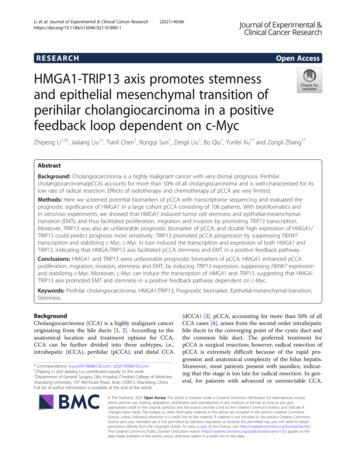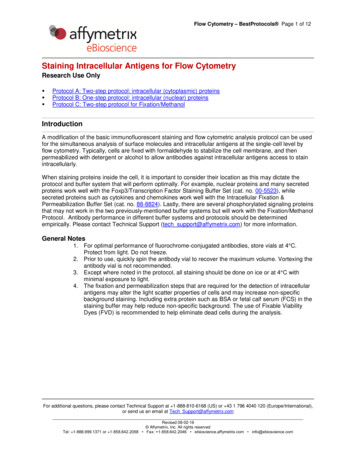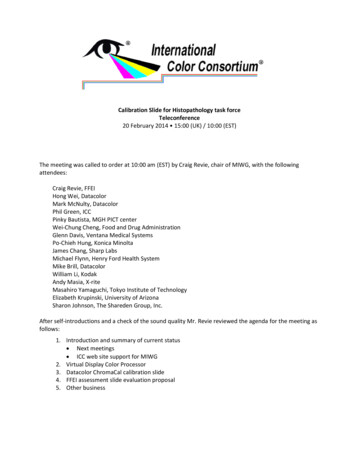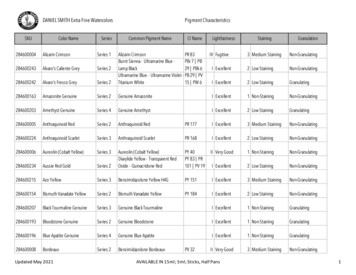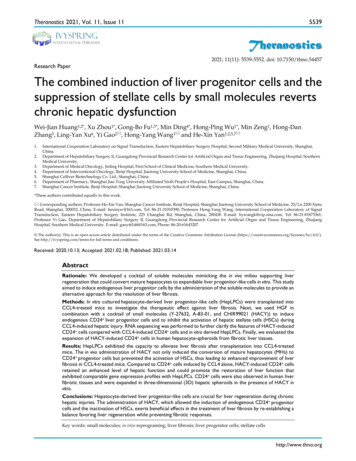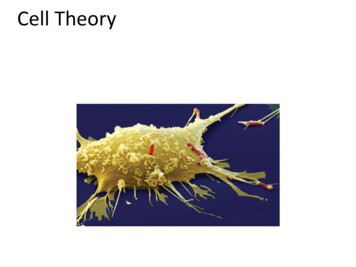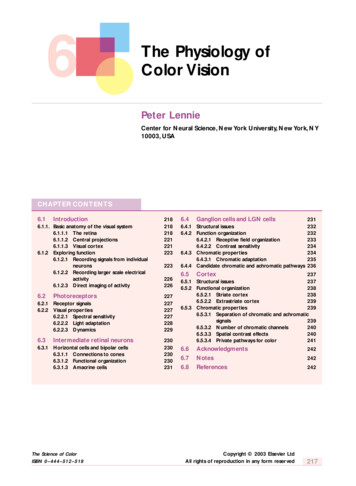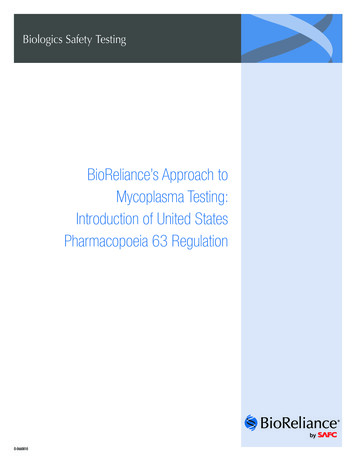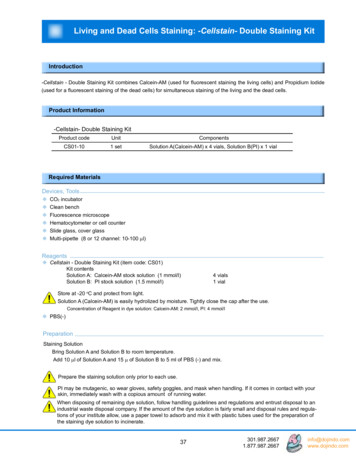
Transcription
Living and Dead Cells Staining: -Cellstain- Double Staining KitIntroduction-Cellstain - Double Staining Kit combines Calcein-AM (used for fluorescent staining the living cells) and Propidium Iodide(used for a fluorescent staining of the dead cells) for simultaneous staining of the living and the dead cells.Product Information-Cellstain- Double Staining KitProduct codeUnitComponentsCS01-101 setSolution A(Calcein-AM) x 4 vials, Solution B(PI) x 1 vialRequired MaterialsDevices, Tools CO2 incubatorClean benchFluorescence microscopeHematocytometer or cell counterSlide glass, cover glassMulti-pipette (8 or 12 channel: 10-100 µl)Reagents Cellstain - Double Staining Kit (item code: CS01)Kit contentsSolution A: Calcein-AM stock solution (1 mmol/l)Solution B: PI stock solution (1.5 mmol/l)4 vials1 vialStore at -20 oC and protect from light.Solution A (Calcein-AM) is easily hydrolized by moisture. Tightly close the cap after the use.Concentration of Reagent in dye solution: Calcein-AM: 2 mmol/l, PI: 4 mmol/l PBS(-)PreparationStaining SolutionBring Solution A and Solution B to room temperature.Add 10 µl of Solution A and 15 µ of Solution B to 5 ml of PBS (-) and mix.Prepare the staining solution only prior to each use.PI may be mutagenic, so wear gloves, safety goggles, and mask when handling. If it comes in contact with yourskin, immediately wash with a copious amount of running water.When disposing of remaining dye solution, follow handling guidelines and regulations and entrust disposal to anindustrial waste disposal company. If the amount of the dye solution is fairly small and disposal rules and regulations of your institute allow, use a paper towel to adsorb and mix it with plastic tubes used for the preparation ofthe staining dye solution to o.comwww.dojindo.com
Living and Dead Cells Staining: -Cellstain- Double Staining KitStaining Procedure for a Fluorescence MicroscopyThe below procedure is used to stain adherent cells. Please be aware that the staining conditions may vary depending onthe cell types and the concentration of the reagent.Procedure Precautions & TipsRecover the cells to be assayed from aculture flask.Recover using the trypsin to detach cells, anduse a cell scraper if necessary.Centrifuge the cell suspension (500 xg for3 min).Remove the supernatant of the media, and add PBS (-). At this step,adjust the cell volume to 105 - 106 cells/ml.When using Dye reagents for staining livingcells, each ester group of the dye will behydrolyzed and fluoresce if esterase remainsin the media. This is one factor for a highbackground, so it is important to wash cellsseveral times.Use a hematocytometer or a cell counter.Gently pipette to avoid damaging the cells.Add 200 µl of the cell suspension to amicrotube.In order to get the best fluorescent image, itis necessary to determine the optimal reagentconcentration and a staining time.Add 100 µl of Staining solution to the same tube.Incubate at 37 oC for 15-30 min with protection from light.Place 10 µl of the cell and staining solution on a glass slide and coverwith a cover glass.38
Living and Dead Cells Staining: -Cellstain- Double Staining KitView the fluorescent image on aIt is possible to observe yellowish-greenstained living cells using a 490 nm excitationfilter. In addition, red stained dead cells canbe observed simultaneously.fluorescence microscope.It is possible to observe the fluorescenceof dead cells stained red using a 545 nmexcitation filter.How to Determine the Optimum Concentration of DyeThe best concentration for Calcein-AM and PI depends on the cell type, so it is necessary to determine the concetrationwhen staining each cell. The best concentration can be determined using the following protocol.Optimum concetration for PIStain the desired cells with 0.1 - 10 µmol/l of PI. Too high concentration of PI will stain not only nuclear but also cytosol, staining concentration should be adjust to appropriate range.Fix the cells prior to staining using one of the method below if necessary:-Treat the cells for 10 min with 0.1 % saponin or 0.1 -0.5% digitonin.-Treat the cells for 30 min with 70% ethanol.Optimum concentration for Calcein-AMUsing the fixed cells to stain with 0.1 - 10 µmol/l of Calcein-AM solution. Determine the concentration range that will notstain all of the fixed cells. Next, using the living cells, determine if the concentration is enough to stain the cells. If sufficient staining has not been obtained, increase the concentration of Calcein-AM.Experimental ExampleSimultaneous staining using -Cellstain- Double Staining KitGreen fluorescence indicates the living cells stained by Calcein-AMusing B excitation filter.Red fluorescence indicates the dead cells stained by PI using Gexcitation mwww.dojindo.com
Living and Dead Cells Staining: -Cellstain- Double Staining KitTroubleshootingProblemPossible CauseSolutionThe cells are not stained well.The staining dye was hydrolized ordecomposed due to the exceedinglylong term storage or incorrect storageconditions.Check the purchase date of the reagent and the storageconditions. If the reagent has been stored for a year fromthe purchase date, do not use. The staining dye may notwork properly.The dye in the working solution was Some of the reagent is unstable in a buffer solution. Inhydrolized or decomposed because particular, viable staining dye is fairly unstable in the bufferthe solution was not freshly prepared. solution. Prepare a working solution only prior to each use.The dye or the working solution wasdecomposed by the exposure to light.The concentration of the dye in theworking solution is too low.Light may accelerate the oxidation process of the dyes.Keep the reagent under the proper storage conditions. Protect the working solution from light during the experiment.Increase the concentration of the dye in the working solution. If there is no change, use Pluronic F-127 or anotherlow toxic detergent to improve the dye uptake by the cellif it is allowedThe dye did not dissolve completely with the solvent. Makesure that the proper solvent was used and the proper concentration was prepared.The dye seems not to stay insideof the viable cell after staining.The dye remains insoluble withthe solvent.High fluorescent background isobserved.The viable cell expels the dye due tothe cell function.Use the stained cell as quickly as possible for your experiments.Not enough reagent was used forthe cells.Probenecid, a transporter inhibitor, may be used to blockthe leakage of the dye from the cell.Since a vacuum centrifuge was usedto prepare the dye product, the dyeis tightly packed on the bottom ofthe tube.Use a vortex mixer or ultra sonic bath to dissolve the dyewith the solvent completely.The dye was decomposed or hydrolizedCheck the purchase date of the reagent & storage conditions. If the reagent has been stored for over a year fromthe purchase date, do not use. The staining dye may bedecomposed or hydrolized.The wrong solvent was used to dissolve.Simultaneuos Staining of living and dead cellsUse the proper solvent to prepare a dye solutionNot enough washing and the dyestill remained after the washingprocess.Repeat washing with PBS(-) or an appropriate buffer toremove excess dye from the cells.Too much dye was used for thestaining.40Reduce the concentration of the dye in the working solution.
Living and Dead Cells StainingQ&A-Cellstain- Double Staining KitQ: What is the principle behind staining the cells?A: Calcein-AM stains living cells, PI stains dead cells. Calcein-AM is a fluorescent dye. The 4 carboxy bases of Calceinare converted to acetoxymethyl (AM) to increase lipid solubility to become cell membrane permiable. Calcein-AMdoes not fluoresce, but after entering the cell, the AM is hydrolized by estarse to form a strong yellowish-green fluorescence. On the other hand, PI is a nucleic acid staining dye, and intercalates with the double helix structure of DNAto produce a particularly strong red fluorescnce after passing through the damaged cell wall of dead cells. PI does notenter into the living cells. By using two different types of dyes, it is possible to stain living cells with yellowish-greencolored fluorescence and stain dead cells with red-colored fluorescence.Q: Tell me about the wavelength when viewing the fluorescence.A: When viewing at the excitation wavelength at 490 10 nm, it will be possible to view living cells stained with yellowishgreen fluorescence and dead cells stained with red-colored fluorescence simultaneously. In addition, it is possible toview only the red colored-fluorescence stained dead cells when using an excitation wavelength of 545 nm.Q: Can this kit be applied to any kind of a cell?A: Basically, it is for all animal cells that have esterase activity. Plant cells and bacteria cells have a cell wall, so CalceinAM is unable to enter such cells and therefore can not stain. It is possible to stain the protoplast.Q: Is it possible to stain any animal cell using the same concentration of dyes?A: It is not the case that the concentration is set same for all of the cells. The optimum concentrations of Calcein-AMand PI differ greatly for each cell type. It is necessary to determine the optimum dye concentration for each cell type.Please refer to page 36 for instructions.Q: Is Calcein-AM toxic to cells?A: Calcein-AM is considerably less toxic compared to the other staining reagents.Refer to the below paper for additional information:L. S. D. Clerck, et al.,J.Immunol. Methods, 172,115 (1994)Q: How should the kit be stored?A: Keep tightly sealed and store at -20 oC. Calcein-AM becomes hydrolyzed by moisture, so do not open the vial until thetemperature of the vial reaches ambient temperature. Also, close the cap tightly after use. Staining solution that hasbeen diluted with buffer or media should be used immediately. PI solution is stable up to one year at -20 oC.Q: What is the method of disposal after use?A: When disposing remaining dye solution and solution containing staining dyes, follow handling guidelines and regulations and entrust disposal to an industrial waste disposal company. If the amount of the dye solution is fairly small anddisposal rules and regulations of your institute allow, use a paper towel to adsorb and mix it with plastic tubes used forthe preparation of the staining dye solution to o.comwww.dojindo.com
Store at o-20 C and protect from light. Solution A (Calcein-AM) is easily hydrolized by moisture. . When disposing of remaining dye solution, follow handling guidelines and regulations and entrust disposal to an industrial waste disposal company. If the amount of the dye solution is fairly small and disposal rules and regula- .
